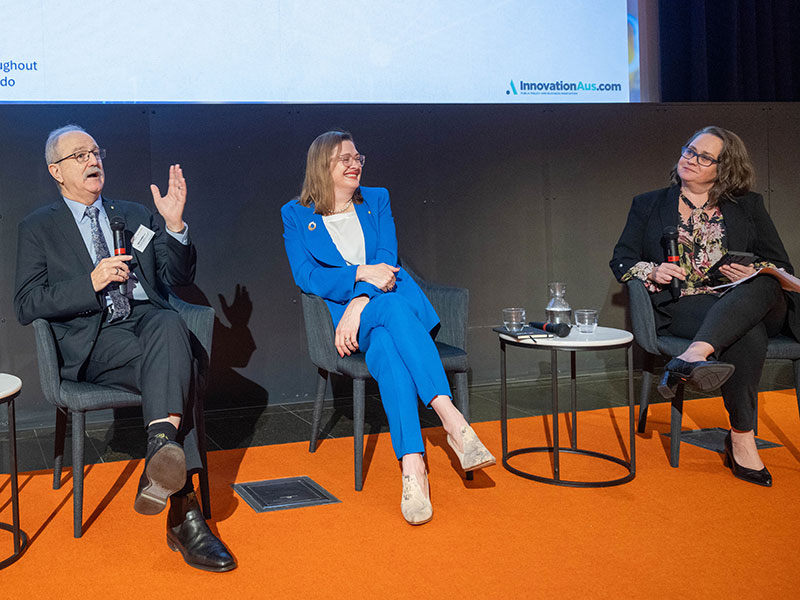Defence has put local dual-use technologies like quantum, sensors and rocket propulsion on its radar to develop an asymmetric advantage amid a geostrategic environment that is demanding capability sooner.
Leaders from Defence’s capability acquisition and innovation systems say the time to acquire the advantage can no longer be compromised, meaning cost and capability will have to bend.
It spells big changes for how industry and researchers are engaged, leading to new commitments to spur innovation, dethatch contracts and “pull through” suppliers’ dual-use products to market.
In Sydney on Friday, Defence’s top technology brass started their pitch with frank concessions.

“Within a resource constrained environment historically we’ve focused on developing the defence industry that only Defence needs,” Chief Defence Scientist Tanya Monro told startups and SMEs at an InnovationAus.com dual-use technology summit in Sydney.
“But we recognise that Defence can be a difficult customer and that it can be difficult to have a viable business model if you only sell to Defence.”
The Albanese government’s Defence Strategic Review last year shook up the Defence establishment, recommending a new approach to capability acquisition within the new posture and structure.
The review — which led to a new National Defence Strategy, investment and industry plans — thrust asymmetric capability and innovation to the front of a new denial strategy.
“A strategy of denial is about deterring a conflict before it starts. It’s about the strategic settings that mean an adversary says ‘today is not the day’ and says that every day,” Professor Monro said.
Defence spends around a quarter of its total budget on capability and acquisition – more than $14 billion each year.
This will jump to $330 billion over a decade and a 42 per cent share of the total budget, Capability Acquisition and Sustainment Deputy Secretary Chris Deeble said.
But as the budget grows, he warned the time to spend it is shrinking, because the historical 10-year warning period for conflict is a luxury Australia no longer has.
In an iron triangle of budget, capability and schedule, the latter increasingly can’t be stretched, he said, so Defence is trying to reduce long lead times and other the barriers to entry for technology suppliers.
“We have probably some of the densest and most bureaucratic processes for procuring capability,” Mr Debble told the event, attended by quantum computing firms, rocket companies and software startups.
“We’ve already started to dethatch that contract framework. We’ve cut 40 per cent of what we asked for of industry at a tender phase… We’ve reduced the paperwork by 45 per cent by weight and volume.”
“So we’re starting on a journey of really thinking about how we go to market and how we do business.”
What Defence is asking for is also changing, with delivery of perfection dumped for “minimum viable capability” that is refined in iterative agile ways in partnership with defence forces and industry.
“It’s the notion that perfection that we sought before, is the enemy of getting capability in the warfighters’ hands as quickly as we possibly can,” Mr Deeble said.
The agile delivery approach will push delivery timeframes from years to month, he said, with a premium placed on relational contracts with industry rather than the transactional approach of the past.
Defence doesn’t want to just plug gaps with the new model, however. It wants to create an asymmetric advantage, making innovation and cutting edge technology critical, Professor Monro said.
“Australia has a huge territory to protect, land and sea. and a small population. We need to be clever and make sure we invest in things that can’t simply be overcome by the application of scale,” she said.
“… Those asymmetric effects can mean just being ahead in a technology and keeping that lead to ourselves. But It is not limited to that, asymmetry can be delivered in many ways, including how well we cooperate between government and industry and with our allies.”
Defence’s new innovation outreach was officially launched almost a year ago, with a new industry accelerator.
The Advanced Strategic Capabilities Accelerator (ASCA) is splitting a $3.8 billion 10-year budget across three programs, ranging from discovery research with universities and defence scientists to innovation ‘incubation’ that rapidly tests and adopts critical technologies.
But in the middle is where most of the ASCA funding is going to run here-year ‘Missions’. The program is designed to acquire cutting edge capabilities co-designed with industry under the lead of a non-defence expert.
The missions don’t launch until there is a clear path to acquisition and agreed offramps for the suppliers for when projects don’t go according to plan.
The first two problem statements were released last year, asking for input on missile strikes and processing intelligence data, while an existing autonomous undersea vehicle project has also been upgraded to a mission after the pathways were established.
“It’s been very challenging, because we’re doing things faster, which is challenging everything we do,” ASCA head Professor Emily Hilder said.
“And in fact, at one point, the program was described as a catastrophic success, which I think is a great compliment.”
Note to readers: If you have any queries about engagement with Defence, or if you would like any additional information about Defence-related technology and innovation programs, please email defence@innovationaus.com
Do you know more? Contact James Riley via Email.

